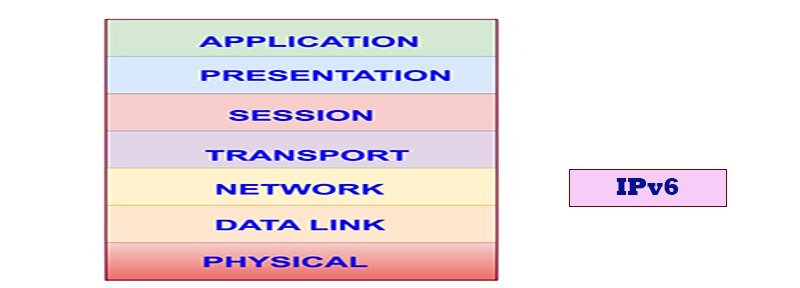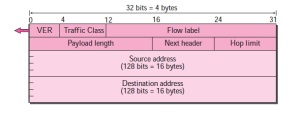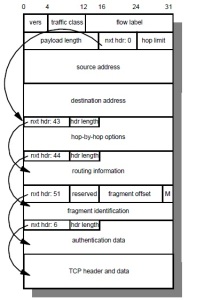
Internet Protocol, Version 6 (IPv6)
Posted on |
Internet Protocol, Version 6 (IPv6)
IP version 6 (IPv6) is a new version of the Internet Protocol, designed as the successor to IP version 4 (IPv4) [RFC-791]. The changes from IPv4 to IPv6 fall primarily into the following categories:
- Expanded Addressing Capabilities: IPv6 increases the IP address size from 32 bits to 128 bits, to support more levels of addressing hierarchy, a much greater number of addressable nodes, and simpler auto-configuration of addresses. The scalability of multicast routing is improved by adding a “scope” field to multicast addresses. And a new type of address called an “anycast address” is defined, used to send a packet to any one of a group of nodes.
- Header Format Simplification: Some IPv4 header fields have been dropped or made optional, to reduce the common-case processing cost of packet handling and to limit the bandwidth cost of the IPv6 header.
- Improved Support for Extensions and Options: Changes in the way IP header options are encoded allows for more efficient forwarding, less stringent limits on the length of options, and greater flexibility for introducing new options in the future.
- Flow Labeling Capability: A new capability is added to enable the labeling of packets belonging to particular traffic “flows” for which the sender requests special handling, such as non-default quality of service or “real-time” service.
- Authentication and Privacy Capabilities: Extensions to support authentication, data integrity, and (optional) data confidentiality are specified for IPv6.
IPv6 Header Format
| Version | 4-bit Internet Protocol version number = 6. |
| Traffic Class | 8-bit traffic class field. |
| Flow Label | 20-bit flow label. |
| Payload Length | 16-bit unsigned integer. Length of the IPv6 payload, i.e., the rest of the packet following this IPv6 header, in octets. |
| Next Header | 8-bit selector. Identifies the type of header immediately following the IPv6 header. Uses the same values as the IPv4 Protocol field |
| Hop Limit | 8-bit unsigned integer. Decremented by 1 by each node that forwards the packet. The packet is discarded if Hop Limit is decremented to zero. |
| Source Address | 128-bit address of the originator of the packet. |
| Destination Address | 128-bit address of the intended recipient of the packet. |
A4C Flash Deals – Up to 95% Off – HURRY Supplies are Limited!
 |
IPv6 Extension Headers
1. Extension Header Order
upper-layer header
Each extension header should occur at most once, except for the Destination Options header which should occur at most twice (once before a Routing header and once before the upper-layer header).
If the upper-layer header is another IPv6 header (in the case of IPv6 being tunneled over or encapsulated in IPv6), it may be followed by its own extension headers, which are separately subject to the same ordering recommendations.
If and when other extension headers are defined, their ordering constraints relative to the above-listed headers must be specified.
IPv6 nodes must accept and attempt to process extension headers in any order and occurring any number of times in the same packet, except for the Hop-by-Hop Options header which is restricted to appear immediately after an IPv6 header only. Nonetheless, it is strongly advised that sources of IPv6 packets adhere to the above-recommended order until and unless subsequent specifications revise that recommendation.
2. Options
3. Hop-by-Hop Options Header
4. Routing Header
5. Fragment Header
6. Destination Options Header
7. No Next Header
 |  |  |
Packet Size
Flow Labels
Traffic Classes
Upper-Layer Protocol Issues
1. Upper-Layer Checksums
Any transport or other upper-layer protocol that includes the addresses from the IP header in its checksum computation must be modified for use over IPv6, to include the 128-bit IPv6 addresses instead of 32-bit IPv4 addresses.
The IPv6 version of ICMP [ICMPv6] includes the above pseudo-header in its checksum computation; this is a change from the IPv4 version of ICMP, which does not include a pseudo-header in its checksum. The reason for the change is to protect ICMP from misdelivery or corruption of those fields of the IPv6 header on which it depends, which, unlike IPv4, are not covered by an internet-layer checksum. The Next Header field in the pseudo-header for ICMP contains the value 58, which identifies the IPv6 version of ICMP.
2. Maximum Packet Lifetime
3. Maximum Upper-Layer Payload Size
4. Responding to Packets Carrying Routing Headers
Books you may interested
 |  |  |  |  |  |
 |  |  |



